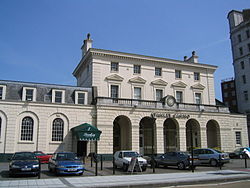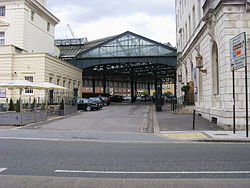(All 9.8.1973 copyright Steve Sainsbury/Rail Thing)
Just six years after the end of steam to Southampton I visited on a Railrover and did some on-foot exploring of the city, looking for rail remnants. I quickly discovered some tram poles (which I doubt are still there!) and then took a look at Terminus station. There were (and still are) running lines to the east of the station, which continue to this day into the docks, but the station itself was completely devoid of tracks.
A walk of about a mile took me to the dock lines which were still in place back then. A few years earlier I'd actually seen a loco (and perhaps train) running on this line which took a roadside and street running course along the city - but nothing to see on that day. But I did get a couple of pics of the actual line - which has now vanished. There are still some tracks set in concrete in parts of the docks - and it's perhaps inevitable that the dock lines will be relaid at some point in the future, but all is quiet now apart from freight trains into Southampton Eastern Docks, these running every couple of hours carrying road vehicles for export. The trains connecting with cruise ships currently no longer run.
A few shots sourced from Google of the line in use. Top two are regular freight workings, the last two are of a railtour in 1976.
Southampton Terminus railway station served the docks and city centre of Southampton, England. The station was first authorised on 25 July 1834,[2] it began as the terminus of the London and South Western Railway (which was the London and Southampton Railway until the line opened). The station opened on 10 June 1839 as "Southampton", although it was not officially operational until 11 May 1840, due to the track not being fully linked betweenWinchester and Basingstoke.
The former terminus station was built in 1839-40 for the London and Southampton Railway, to the design of Sir William Tite. The LSWR added the large South Western Hotel which rather dwarfs the station. The line was later extended into the Ocean Dock Terminal to allow boat trains to terminate on the quayside.
History
During the building of the track between Winchester and Basingstoke, the London and Southampton Railway company renamed itself the London and South Western Railway. When it opened it was the only station in the area and so called "Southampton". Initially it had two platforms and an engine shed.
The station did not originally handle passenger services because of a dispute over running rights. To overcome this, a small open platform at Northam Road, opened. Access was from Bridge Road Level Crossing which was demolished in 1882 when the new "Central Bridge" was built. This remains a major route into Southampton from Woolston; at both ends of the bridge are plaques dedicated to the railway.
In 1847 engine sheds and a turntable were built.
During July 1858 Southampton was renamed "Southampton Docks" to distinguish it from "Southampton West" Railway Station. During the 1860s, additional sidings and sheds were built, followed by the "Imperial Hotel".
Hotel
Standing at the southern end of the station the "Imperial Hotel" was later renamed as "South Western Hotel". The building was acquired by the military in the Second World War and became HMS Shrapnel. After the war it was renamed "South Western House" and was converted to offices. In 1961 the BBC opened a new BBC South region and used the former Ball-Room as the main studio for their local news programme until 1991. The building was converted into private flats in 1998.
More development took place during the early 1870s when land on the station's eastern side was purchased, which allowed the railway to expand. Much larger goods sidings, a telegraph office and buildings for shipping businesses were built. At the same time the platforms were extended.
The London and South Western Railway purchased more land during 1876, north of the terminus, and built new locomotive work sheds and a turntable. Three new platforms, two arranged as an islandwere opened 1891. The goods and parcel yard which were located at St. Lawrence Road were improved.
In 1895 the old 1847 engine sheds were still heavily in use but as demand rose for goods, they were converted into a one road depot for freight trains. The original turntable was replaced with an open turntable which had radiating roads, coal stage, water columns and crew bothy. Over the years the turntable was repeatedly improved and eventually became a 70-foot (21-metre) vacuum turntable, which was closed and removed in September 1966.
During September 1896 the station was again renamed to "Southampton Town & Docks", later changing to "Southampton Town for Docks" in November 1912 and finally being renamed to "Southampton Terminus" on 9 July 1923,
The building played host to many distinguished guests. Two such notable ones were Winston Churchill and Dwight Eisenhower during the Second World War. The men reportedly discussed the D Day invasion in one of the small public rooms on the first floor. Queen Elizabeth the Queen Mother also reportedly visited the Hotel and danced in the Wedgwood Ballroom.
Decline
In the early 1900s, Southampton Terminus saw increased traffic from locations such as Reading, Alton, London, Portsmouth and by 1905 traffic from the Great Western Railway via the Didcot, Newbury and Southampton Railway.
Southampton Terminus is remembered for the many passengers of RMS Titanic who passed through it. Many of the RMS Titanic's wealthy First Class passengers stayed in the South Western Hotel next to Southampton Terminus before they boarded for their disastrous journey.
As road transport became more common the platforms at Southampton Terminus began to shrink, first to accommodate a private road between the railway station and the hotel. To make the station more comfortable for its users, a glass canopy was erected in 1924. Two years later in 1926 a new parcel and mail office was built. Around this time the station platform numbers were reversed and numbered to left to right from the prior right to left.
Closure
The station closed for passengers and parcels on 5 September 1966 prior to electrification between London Waterloo and Bournemouth when neither Northam Railway Station or Southampton Terminus were included in the upgrade. The mail offices closed the following year in December 1967, transferring their work to Southampton Central. By December 1968 most of the track had already been removed. In 1970 the remaining signal box and track work was removed and the running lines filled in to platform level to act as a car park.
| Preceding station | Disused railways | Following station | ||
|---|---|---|---|---|
| Northam Line and station closed | London & South Western Railway London and Southampton Railway | Terminus | ||
Architecture
The main building in the Italianate style, by Sir William Tite, is a Grade II* listed building and is used as a casino, operated by the Genting Group.
Motive Power Depots
Motive power depots were situated at Southampton Terminus Station and nearby in Southampton Docks. The first of these was opened 10 June 1839 by the London and Southampton Railway, but was demolished due to track widening. This was replaced by another structure adjacent to the goods shed, but this was closed in 1895. It was replaced by an outdoor servicing facility north of the station, which included a turntable coal stage and offices. These remained open until 1966.
An engine shed was opened in Southampton Docks, by the Southampton Docks Railway Company in 1865. It was rebuilt in 1879, and taken over by the London and South Western Railway in 1892. The building was enlarged and re-roofed by the Southern Railway during the 1930s and rebuilt by British Railways in 1955. It was officially closed in January 1966, but remained in use until July 1967.
The Southern Railway opened an outdoor locomotive servicing facility in the New Docks in 1933 and added a turntable in 1949. This remained in use until 1966.
Today
Southampton Central is now the main railway station in Southampton.
The former Terminus station building is now a casino. The South Western Hotel was converted into apartments. The private road into what would be the platforms is now a car park. Of the platforms, all that remains is the glass canopy and a single line that runs from Northam junction to the docks.
Plans for a future railway station
A £10 million plan was put forward in 1999 to reopen Southampton Terminus and Northam Station, which was to have been controlled by East Anglia Railways Train Company. Their plans included building a new rail-link using the current remaining track by St. Marys Stadium and as far as the Waterfront, which is now safeguarded bySouthampton City Council for future rail links. It was also hoped it would reduce the traffic around Southampton with a local commuter line linking the Waterfront to Romsey, Halterworth and Chandler's Ford. The plan failed to come about for reasons unknown.
Southampton City Council has safeguarded the remaining land for future use to build a small railway station on the former down line at Canute Road level crossing, opposite the former Southampton Terminus railway station. The project is named TI4 Waterfront Station.








Steve you may be pleased to know the line into the Eastern docks although just a long siding from Northam sees at least one car train a day, sometimes two, and often loaded in both directions. It's a small but healthy freight lifeline. Also the huge grain silos that were once rail served are still in place at the end of Eastern Docks, waiting for a revival one day?
ReplyDelete